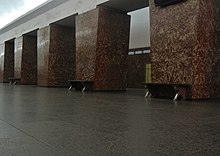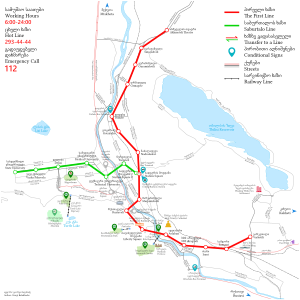Tbilisi Metro
| Tbilisi Metro | |||
|---|---|---|---|
 | |||
| Overview | |||
| Native name | თბილისის მეტროპოლიტენი tbilisis metropoliteni | ||
| Locale | Tbilisi, Georgia | ||
| Transit type | Rapid transit | ||
| Number of lines | 2 | ||
| Number of stations | 23 | ||
| Daily ridership | ≈400 000 (avg. weekday, 2019) | ||
| Annual ridership | |||
| Website | Tbilisi Transport Company | ||
| Operation | |||
| Began operation | 11 January 1966[2] | ||
| Operator(s) | Tbilisi Transport Company | ||
| Number of vehicles | 170[3] | ||
| Train length | 4 cars | ||
| Technical | |||
| System length | 27.3 km (17.0 mi)[3] | ||
| Average speed | 38 km/h (24 mph) | ||
| Top speed | 90 kilometres per hour (56 mph) | ||
| |||
The Tbilisi Metro (Georgian: თბილისის მეტროპოლიტენი) is a rapid transit system in the Georgian capital Tbilisi. Opened on 11 January 1966, it was the fourth metro system in the former Soviet Union. Like other ex-Soviet metros, most of the stations are very deep and vividly decorated.
At present the system consists of two lines, 27.3 kilometres (17.0 mi) in total length, serving 23 stations.[3] In 2017, the Metro transported 113.827 million passengers.[1] The Metro is operated by the Tbilisi Transport Company, which began operation the same year as the Tbilisi Metro, in 1966.[4]
History
Tbilisi (officially known as Tiflis until 1936), capital of Georgia, was considered historically to be one of the most important cities of the Soviet Union, particularly in view of its political position as being the most significant city in the Caucasus and the capital of the Transcaucasian Socialist Federative Soviet Republic which lasted until 1936. The city grew quite rapidly during the 19th and 20th centuries, and apart from being a cultural and political centre, it was also an important transport hub in Transcaucasia and an industrial center as well. Features of the historically established development of Tbilisi, stretching for more than 25 km along the Mtkvari river, densely built-up city centre, narrow steep streets in some parts of the city, impede the development of land transport.[5] All this contributed to the need for a rapid transit Metro system. Especially considering its geographic characteristic - Tbilisi is considerably long, which undoubtedly would simplify the coverage of most parts of the city by the underground.
Construction began in 1952.[6] Tbilisi was the one of the only cities of the former USSR where the construction of the Metro system started before the resident population exceeded one million. A population over one million was one of the main criteria for building a metro system in Soviet cities.
On 11 January 1966, the Tbilisi Metro was opened:[6] it was the first and only Metro system in Georgia and the fourth one in the former Soviet Union (after Moscow, Saint Petersburg, and Kiyv), when the first six stations were opened. Since then, the system has steadily grown to a two line, 23 station network.
During the 1990s, most of the Soviet-era station names were changed, although financial difficulties after the breakup of the Soviet Union hit the Metro particularly hard in its infrastructure, operations, and extensions. In the early-mid 1990s the Tbilisi metro was usually not working due to the lack of electricity.[7] Until recently, the Metro had been underfunded and operated in severe difficulties due to poor electrical supply. It had also become infamous for widespread petty crime, like pickpocketing and mugging.[citation needed] In addition, there have been several incidents at metro stations in recent years. On 9 October 1997, a former policeman blew himself up at Didube station. On 14 February 2000, a teenager threw a homemade hand grenade into a metro station, injuring several people. In March 2004, several people were poisoned by an unidentified gas while using the Metro. However, the crime has reduced as a result of security and administration reforms in the system from 2004 to 2005. Other services have also significantly improved.
The Tbilisi Metro system is undergoing a major rehabilitation effort, including the reconstruction of the stations as well as the modernization of trains and other facilities. The city's 2006 budget allocated 16 million lari for this project. Former President of Georgia Mikheil Saakashvili promised to make the Metro a most prestigious public transport system, and charged Director General of Tbilisi Metro, Zurab Kikalishvili, in late 2005, to bring the metro up to European standards by 2007. From 2005 began the renovation process of subway trains. As part of the modernization, the soviet-era rolling stock was overhauled, old parts were replaced with new ones, the interior of the car was changed and the exterior was given a different look. Additionally, the driver cab was equipped with a modern control panel.[8] In subsequent years, however, the upgrade process has slowed significantly, and as of July 2010, the Tbilisi metro rail was still far from its target standard. Some renovated metro stations had to be repaired again soon due to deficient planning and poor quality of renovation. The renovation process of the system continues unfortunately slowly and there are several stations under renovation. As of 2020[update] Tbilisi city hall plans to purchase 10 4-car trains for Tbilisi Metro,[9] which will meet European standards.
The extension of Saburtalo Line to State University station began in 1985. In 1993 the construction was stopped and it went into conservation mode. In January 2012 construction was scheduled to start on a frozen extension of the Saburtalo Line from the Vazha-Pshavela station to the Sakhelmtsipo Universiteti (State University) station, of which 80% of the work was completed during the Soviet era. But it was only restarted in July 2015 with financial help from the Asian Development Bank and the station was finally opened to the public on 16 October 2017.[10] The new State University station meets modern standards and is equipped with new technologies. Additionally, Delisi-Vazha-Pshavela tunnel was also opened.

In 2019, the complete rehabilitation of power lines and ventilation systems in the metro began. With the replacement of the 450-kilometer power cable, 32 new European-standard fans will be installed. The Asian Development Bank has allocated $ 15 million for this project.[11]
Network




- Current lines
| No. | Name | Opened | Length | Stations |
|---|---|---|---|---|
| 1 | Akhmeteli–Varketili Line | 1966 | 19.6 km (12.2 mi) | 16 |
| 2 | Saburtalo Line | 1979 | 7.7 km (4.8 mi) | 7 |
| TOTAL: | 27.3 km (17.0 mi) | 23 | ||
Timeline
| Segment | Date opened | Length |
|---|---|---|
| Didube–Rustaveli | 11 January 1966 | 6.3 km |
| Rustaveli–300 Aragveli | 6 November 1967 | 3.5 km |
| 300 Aragveli–Samgori | 5 May 1971 | 2.4 km |
| Sadguris Moedani–Delisi | 15 September 1979 | 5.5 km |
| Samgori–Varketili | 8 November 1985 | 1.7 km |
| Didube–Guramishvili | 16 November 1985 | 3.4 km |
| Guramishvili–Akhmetelis Teatri | 7 January 1989 | 2.3 km |
| Delisi–Vazha-Pshavela | 2 April 2000 | 1.2 km |
| Vazha-Pshavela–Sakhelmtsipo Universiteti | 16 October 2017 | 1.0 km |
| Total: | 23 stations | 27.3 km |
Operation

As of 2018[update], the system consists of two lines, serving 23 stations, operating on 27.3 kilometres (17.0 mi) of route and 62.5 kilometres (38.8 mi) of track.[3] Of the 23 stations, 21 stations are below ground and two are surface level.[citation needed] Of the subterranean stations, 17 are deep level and 4 shallow.[citation needed] The former comprise 6 pylon stations, 5 column and 6 single vaults (built to the Leningrad Technology). The shallow stations consist of three pillar-trispans and one single vault (Kharkov Technology). Due to Tbilisi's uneven landscape, the Metro, particularly the Akhmeteli-Varketili line, has one surface-level section.
An estimated total of 105.6 million people used the Metro annually as at 2005,[12] though the actual figure by 2012 was closer to 94 million. Carrying them are a fleet of 170 Soviet-built rail cars, consisting of the 81–717/714 and Еzh3 models, which operate from two depots. Station platforms are built to accommodate five-carriage trains, though four- car trains operate on both lines of the subway system.
Trains run from a little before 6:00 am (exact times vary depending on the station) until midnight,[13] with intervals ranging between 2 1/2 minutes at peak times to 12 minutes later in the night. Train speeds are 60–90 kilometres per hour, while the average trip speed is slightly over 33 kilometres per hour.
Fares
The Tbilisi Metro uses a flat-fare system of 50 tetri per journey. Tokens are no longer used, and riders must purchase for 2 lari a Metromoney Card (a stored value card available at metro stations), onto which they can add fares. The card allows riders to re-enter the system for 90 minutes upon leaving it at no charge.[14]
Future
The system had also an advanced extension plan, with a third line, amongst other locations, encompass the district of Vake. Forming a typical Soviet triangle with three-line six radii layout intersecting in the city centre. However, most of the construction sites remain frozen, some dating to Soviet times.[15]
There are also plans to return a tram network in Tbilisi.[16]
In October 2018, the Prime Minister of Georgia, Mamuka Bakhtadze announced during the Georgian Dream conference that 7 new stations will form a new line connecting central Tbilisi with outskirts of the city and Tbilisi Shota Rustaveli Airport. According to the plan, the new overground line will run from Samgori metro station to the Lilo market in east of the city. The mayor Kakha Kaladze added, that the line is planned to be extended to Rustavi, a major city 30 km away from the capital. Although, this still remains a plan up until the overground line is open.[17]
See also
References
- ^ a b "Tbilisi in figures 2018" (PDF). Tbilisi City Hall. 12 June 2018. p. 44.
- ^ "About Tbilisi Transport Company". ttc.com.ge. Tbilisi Transport Company. Retrieved 19 July 2020.
- ^ a b c d "Annual Report 2012" (PDF). Tbilisi Transport Company. pp. 24–27. Retrieved 16 November 2013.
- ^ "Tbilisi Transport Company". ttc.com.ge. Retrieved 19 July 2020.
- ^ "Мы строим метро (книга, часть 5)". wiki.nashtransport.ru. Retrieved 19 July 2020.
- ^ a b "Tbilisi Transport Company History". ttc.com.ge. Tbilisi Transport Company. Retrieved 19 July 2020.
- ^ Goltz, Thomas (2006). Georgia Diary: A Chronicle of War and Political Chaos in the Post-Soviet Caucasus. Sharpe. ISBN 0-765617-102.
- ^ "Refurbished metro trainsets enter service in Tbilisi". railwaygazette.com. Retrieved 19 July 2020.
- ^ "EBRD finances modernisation of Tbilisi metro". ebrd.com. Retrieved 19 July 2020.
- ^ "New University Metro station opens in Tbilisi". agenda.ge. Retrieved 19 July 2020.
- ^ "Asian Development Bank finances repair work on Tbilisi Metro with $15 mln". agenda.ge. agenda.ge. Retrieved 19 July 2020.
- ^ State Department of Statistics of Georgia
- ^ "Tbilisi Transport Company". ttc.com.ge. Archived from the original on 28 November 2016.
- ^ "Standard tariff and discounts". Tbilisi Transport Company. Retrieved 20 July 2019.
- ^ "Third line of Tbilisi Metro". at.ge. Retrieved 19 July 2020.
- ^ "Tbilisi tram design contract signed". Railway Gazette International. 22 December 2010. Retrieved 16 November 2013.
- ^ "New metro stations to link center and outskirts of Tbilisi". Vestnik Kavkaza. 22 October 2018. Retrieved 15 January 2019.
External links
- Tbilisi Transport Company – official Metro website (in English)
- Tbilisi at UrbanRail.net (in English)
- Tbilisi at Metroworld (in Russian)
- Tbilisi Metro at cityrailtransit.com (in English)
- Metrosoyuza (in German and Russian)
- Tbilisi Metro (in Russian)
- Metasubway Tbilisi (in English and Russian)


